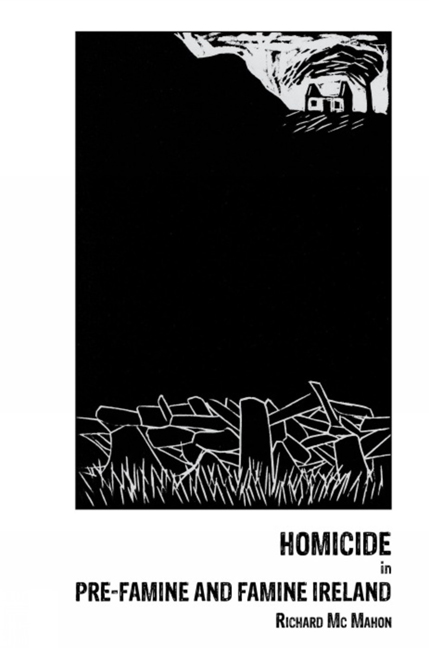Book contents
- Frontmatter
- Dedication
- Contents
- List of tables and figures
- Preface
- ‘A violent society’?
- 1 Homicide rates in Ireland, 1801–1850
- 2 ‘Do you want to pick a fight out of me?’: Homicide and personal relations
- 3 ‘Sending them to heaven’: Homicide and the family
- 4 ‘The tranquillity of a barrel of gun powder’: Homicide and land
- 5 ‘The madness of party’: Homicide and sectarianism
- Conclusion
- Appendix one: Methods and sources
- Appendix two: Homicide and motive
- Bibliography
- Index
Appendix one: Methods and sources
- Frontmatter
- Dedication
- Contents
- List of tables and figures
- Preface
- ‘A violent society’?
- 1 Homicide rates in Ireland, 1801–1850
- 2 ‘Do you want to pick a fight out of me?’: Homicide and personal relations
- 3 ‘Sending them to heaven’: Homicide and the family
- 4 ‘The tranquillity of a barrel of gun powder’: Homicide and land
- 5 ‘The madness of party’: Homicide and sectarianism
- Conclusion
- Appendix one: Methods and sources
- Appendix two: Homicide and motive
- Bibliography
- Index
Summary
A quantitative analysis of homicide is by no means an unproblematic exercise. Both historians of crime and criminologists have long recognised the difficulties involved in the use of official records of crime as indicators of wider patterns of criminal behaviour, and any study of homicide depends on the availability and reliability of official sources. It is necessary, therefore, to reflect on some of the main methodological problems involved in using the available sources for a study of crime in general and of homicide, in particular, in Ireland from 1801 to 1850.
Methods
Is it possible to understand wider patterns of criminal activity through an analysis of criminal statistics? There is no shortage of debate on this issue within the existing historiography. While there are a number of different approaches, broadly speaking, there are two views on the question: (a) those who argue that statistics can, in certain circumstances, provide an insight into actual criminal activity, and (b) those who reject this argument and claim that criminal statistics can only be used to gain an understanding of the interests, priorities and assumptions of the authorities.
In the context of the nineteenth century, V.A.C Gatrell provides perhaps the most sophisticated defence of the first position by adopting what might be termed a (qualified) positivist approach. From this perspective, crime statistics, while by no means a wholly accurate reflection of actual crime levels are, if interpreted judiciously, the best available indication of patterns of criminal activity. Gatrell acknowledges that ‘crime rates cannot tell us how much crime […] is committed in society.’ This is due not only to the fact that there are limits to the capacities of the authorities in detecting and recording crime, but also because the priorities, interests and assumptions of the authorities themselves can impact in significant ways on the pattern of recorded crime. This, of course, raises serious difficulties in using the statistics in order, for instance, to assess long-term trends. Changing priorities may impact upon the levels of recorded crime, or the levels of crime recorded, thereby offering a false picture of the actual state of criminal activity.
- Type
- Chapter
- Information
- Homicide in pre-Famine and Famine Ireland , pp. 176 - 192Publisher: Liverpool University PressPrint publication year: 2013



